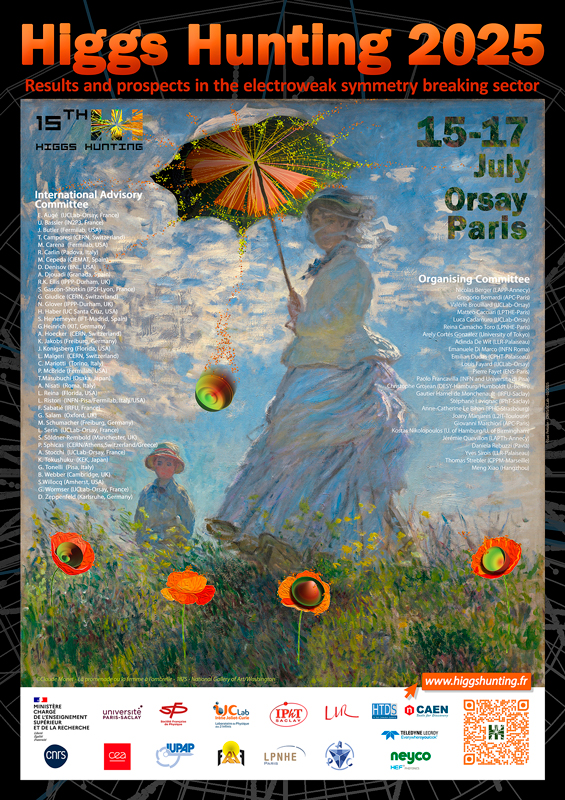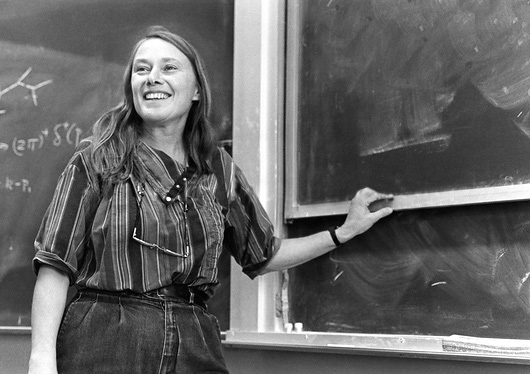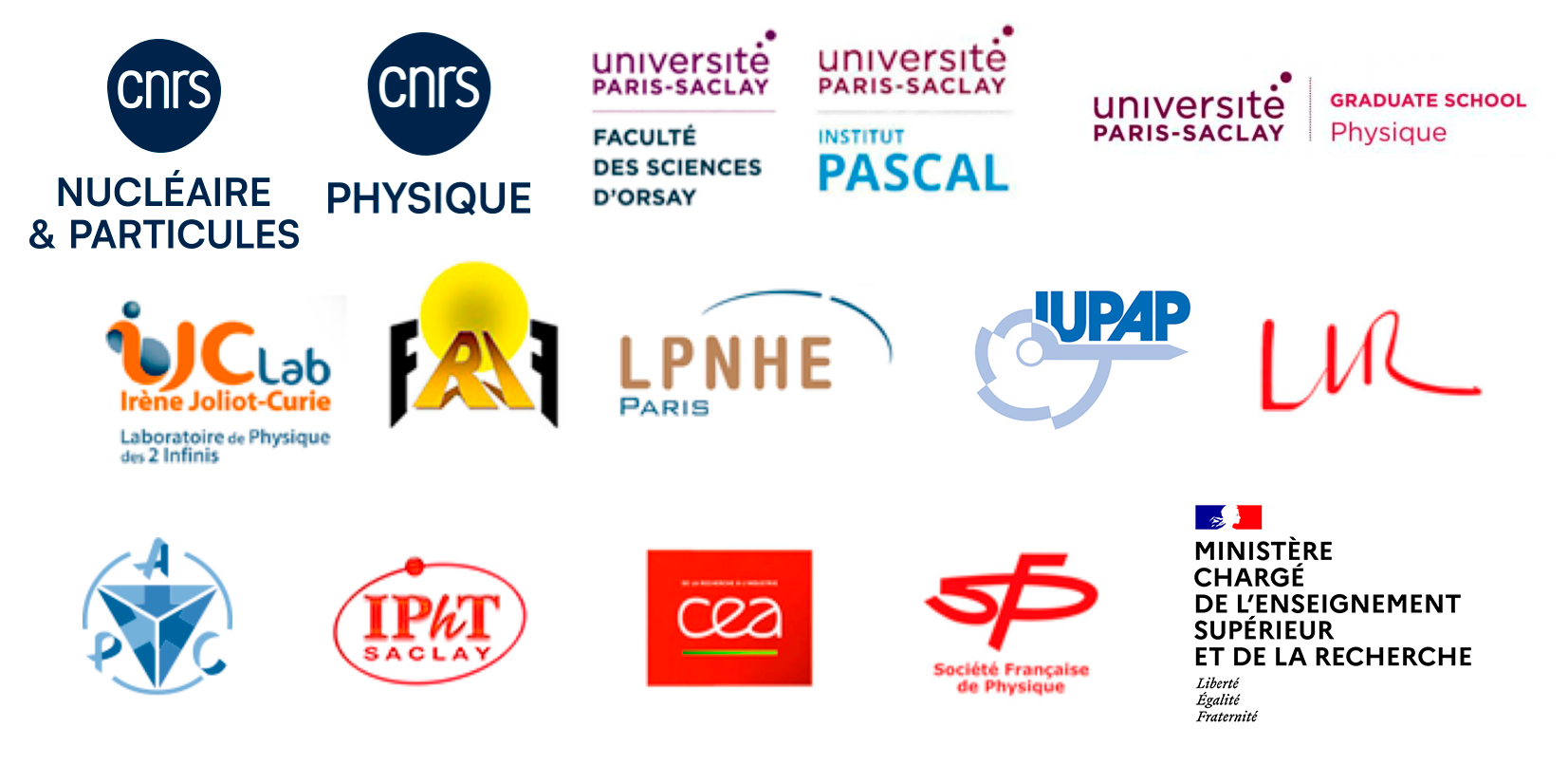Higgs Hunting 2025
100/-1-A900 - Auditorium Joliot Curie
IJCLab
 The origin of Electroweak symmetry breaking is one of the central topics of research in fundamental physics. The discovery of a Higgs boson at CERN on July 4th, 2012, following a hunt that spanned several decades and multiple colliders, changed the landscape of these investigations and provided key evidence for the Brout-Englert-Higgs mechanism of mass generation through the spontaneous breaking of Electroweak symmetry.
The origin of Electroweak symmetry breaking is one of the central topics of research in fundamental physics. The discovery of a Higgs boson at CERN on July 4th, 2012, following a hunt that spanned several decades and multiple colliders, changed the landscape of these investigations and provided key evidence for the Brout-Englert-Higgs mechanism of mass generation through the spontaneous breaking of Electroweak symmetry.
More than ten years later, the hunt goes on several fronts, in particular for:
- New physics through precision studies of the properties of the Higgs boson : in particular its mass, spin and couplings to other Standard Model particles.
- New production and decay modes, in particular in processes involving multiple Higgs bosons which provide key insight into the shape of the Higgs potential.
- New Higgs-like states and signals for physics beyond the Standard Model.
The 15th workshop of the « Higgs Hunting » series organized on July 15-17 2025 will present an overview of these topics, focusing in particular on new developments in the LHC Run-2 analyses, detailed studies of Higgs boson properties and possible deviations from Standard Model predictions. Highlights will also include a first look at LHC Run-3 analyses, prospects from studies at future colliders, and recent theoretical developments.
The workshop will be held in person in Orsay, for the first day, and Paris, for the two following days, to continue the Higgs Hunting tradition of lively discussions during and after the sessions. Remote participation will also be made possible for those unable to attend in person. No registration fees are asked for remote participation.
|
 Mary K. Gaillard passed away on 23 May 2025. A major figure in particle theory, she made fundamental contributions to the establishment of the Standard Model. Notably, she achieved a successful determination of the charm quark mass from kaon decays; predicted three-jet events in e+ e- collisions, providing crucial evidence for the existence of gluons; and forecasted the bottom quark mass within the framework of unified theories. She also pioneered systematic studies of Higgs boson production and decay at particle colliders, sketching its first phenomenological profile that launched its experimental hunt. Beyond the Standard Model, Mary K. made numerous and invaluable contributions to Grand Unified Theories and supersymmetric theories, including work on proton decay, supersymmetry breaking, and effective supergravity theories derived from superstrings. The Higgs Hunting workshop was honored to welcome her in 2016 as the speaker for its traditional historical talk Mary K. Gaillard passed away on 23 May 2025. A major figure in particle theory, she made fundamental contributions to the establishment of the Standard Model. Notably, she achieved a successful determination of the charm quark mass from kaon decays; predicted three-jet events in e+ e- collisions, providing crucial evidence for the existence of gluons; and forecasted the bottom quark mass within the framework of unified theories. She also pioneered systematic studies of Higgs boson production and decay at particle colliders, sketching its first phenomenological profile that launched its experimental hunt. Beyond the Standard Model, Mary K. made numerous and invaluable contributions to Grand Unified Theories and supersymmetric theories, including work on proton decay, supersymmetry breaking, and effective supergravity theories derived from superstrings. The Higgs Hunting workshop was honored to welcome her in 2016 as the speaker for its traditional historical talkthan you can see in
Mary K. spent a substantial portion of her career in France and at CERN, from her doctoral studies in Orsay to the creation of the theoretical physics laboratory LAPTh in Annecy. The Higgs Hunting workshop extends its deepest condolences to her colleagues at the University of California, Berkeley, and to her family. |

 |
 |
 |
|
-
-
09:00
Registration (with coffee and croissants) 100/-1-A900 - Auditorium Joliot Curie
100/-1-A900 - Auditorium Joliot Curie
IJCLab
IJCLab Orsay (Tuesday) & APC Paris (Wednesday & Thursday)140Montrer la salle sur la carte -
1
Prelude from the organizers 100/-1-A900 - Auditorium Joliot Curie
100/-1-A900 - Auditorium Joliot Curie
IJCLab
IJCLab Orsay (Tuesday) & APC Paris (Wednesday & Thursday)140Montrer la salle sur la carte -
-
3
Orateur: Neha Rawal (University of Florida)Abstract Ever since the discovery of the Higgs boson by the ATLAS and CMS Collaborations at LHC in 2012, precision measurements of its properties have been performed intensively. This is crucial for further understanding the Standard Model (SM) as well as to search for beyond the SM physics. This presentation focuses on precision measurements of the Higgs boson mass and total decay width performed using proton-proton collision data collected by the CMS detector during Run 2 of the LHC. It includes analysis strategies and techniques for precise and accurate measurement of the mass and discusses direct measurement of the width from the Higgs resonance peak. We also highlight studies on indirect width measurements which provide a better constraint on its value compared to direct measurements which are limited by the detector resolution.
-
4
Orateur: Yangfan Zhang (University of Science and Technology of China)
-
3
-
Président de session: Nick Wardle (Imperial College)
-
5
Orateur: Amrutha Krishna (Northeastern University)
-
6
Orateur: Elise Le Boulicaut (Yale University)
-
7
Orateur: Walaa Elmetenawee (Universita e INFN, Bari)
-
8
Orateur: Fábio Lucio Alves (Nanjing University)
-
9
Orateur: Nicholas Wardle (Imperial College London)
-
10
-
5
-
13:00
Lunch Bures cafeteria (Orsay)
Bures cafeteria
Orsay
-
Président de session: Roberto SALERNO (LLR)
-
11
Orateur: Greta Brianti (Università di Trento)
-
12
Orateur: Angela Zaza (Univ. di Bari e Sez. dell'INFN)Abstract Probing the Higgs boson coupling to second generation quarks, still out of reach, is currently one of the most challenging goals of the CMS and ATLAS collaborations. The CMS collaboration carried out searches for the Higgs boson decay in a charm quark-antiquark pair with data collected during the Run-2 of the LHC (2016-2018), by exploring the Higgs boson associated production with a vector boson (VH) , the gluon fusion (ggF) and the associated production with a top quark-antiquark pair (ttH) production mechanisms. By combining the ttH and VH production mechanisms, CMS set the most stringent constraint to date on the Hcc Yukawa coupling modifier: |kc| < 3.5 (2.7). An overview on the searches for H→cc carried out by the CMS collaboration will be presented in this contribution.
-
11
-
Président de session: Roberto SALERNO (LLR)
-
14
Orateurs: Lorenzo Santi (CERN), Lorenzo santi (INFN - Roma1)
-
15
Orateurs: Leonidas Paizanos (University of Cyprus), Leonidas Paizanos (University of Cyprus)
-
16
Orateur: Roberto SALERNO (LLR)
-
17
-
14
-
16:30
Coffee break 100/-1-A900 - Auditorium Joliot Curie
100/-1-A900 - Auditorium Joliot Curie
IJCLab
IJCLab Orsay (Tuesday) & APC Paris (Wednesday & Thursday)140Montrer la salle sur la carte -
Président de session: Ben Kilminster (Universität Zürich)
-
19
Orateur: Benedetta Camaiani (Univ. di Firenze e Sez. dell'INFN)Abstract We present the differential measurement of H+jets in the WW decay channel using full run 2 CMS data. The measurements presented probe the CP nature of the Higgs boson couplings. A novel approach was used, exploiting adversarial neural network, to minimize model dependency of the measurement and allow reinterpretability. Constraints on several Wilson coefficients are also derived.
-
20
Orateur: Víctor Enguita Vileta (Instituto de Física Teórica (IFT) UAM-CSIC)
-
21
An Isotropic Prescription for Constructing the SMEFT in Normal Coordinates to Simplify Amplitude ComputationsOrateur: Mia West (University of Florida)
Geometry provides us with a convenient interpretation of field-redefinition invariance for amplitudes and has many useful properties. For instance, it directs us towards Riemann Normal Coordinates (RNC) as an ideal choice of field-redefinition to compute amplitudes. It has been shown in the Higgs Effective Field Theory (EFT) assuming custodial symmetry & in the high-energy limit in RNC there are distinct kinematics for each Feynman graph. Redefining the Lagrangian in these coordinates appears to generate a reduced set of Feynman graphs which still sum to the correct amplitude. This property also holds in the Standard Model EFT (SMEFT) as a subset of HEFT. In this talk, we will demonstrate a prescription to construct the SMEFT in RNC around the symmetric point using isotropy, applicable to all orders in the SMEFT expansion. Then, breaking electroweak symmetry corresponds to traversing a geodesic to the vacuum and re-establishing RNC in terms of isotropic properties of the symmetric point. We argue that this prescription is simpler compared to the usual recursive method to construct RNC.
-
19
-
Historical talk 100/-1-A900 - Auditorium Joliot Curie
100/-1-A900 - Auditorium Joliot Curie
IJCLab
IJCLab Orsay (Tuesday) & APC Paris (Wednesday & Thursday)140Montrer la salle sur la cartePrésident de session: Ben Kilminster (Universität Zürich)- 22
-
19:00
Welcome cocktail 100/-1-A900 - Auditorium Joliot Curie
100/-1-A900 - Auditorium Joliot Curie
IJCLab
IJCLab Orsay (Tuesday) & APC Paris (Wednesday & Thursday)140Montrer la salle sur la carte
-
09:00
-
-
09:25
Coffee LPNHE Paris
LPNHE Paris
-
Président de session: Sven Heinemeyer (IFT/IFCA (CSIC))
-
23
Orateur: Federica De Riggi (Univ. di Roma I e Sez. dell'INFN)
-
23
-
-
Plenary: BSM H(125) aspects and searches for new scalar bosons Amphithéâtre Charpak (LPNHE Paris)
Amphithéâtre Charpak
LPNHE Paris
Président de session: Sven Heinemeyer (IFT/IFCA (CSIC))-
25
Orateur: Siddhesh Sawant (Baylor University)
-
26
Orateur: Eleni Skorda (University of Birmingham)
-
27
Orateur: Sven Heinemeyer (IFT/IFCA (CSIC))
- 28
-
25
-
11:55
Lunch buffet LPNHE Paris
LPNHE Paris
-
Président de session: Julie Malcles (CEA-Saclay/Irfu, Université Paris-Saclay)
-
29
Orateur: Maria Mazza (Florida State University)
-
30
Orateur: Andrea Sciandra (UCSC)
-
31
Orateur: Julie Malcles (CEA-Saclay/Irfu, Université Paris-Saclay)
- 32
-
29
-
Président de session: Julie Malcles (CEA-Saclay/Irfu, Université Paris-Saclay)
-
33
Orateur: Wanda Isnard (IP2I Lyon)
- 34
-
35
Orateur: Marko Pesut (University of Zurich)
Abstract: In the first part of the talk, we will introduce the main model building ideas (flavour non-universality and Higgs compositeness) that are central to our model, as well as the theoretical and experimental motivations for exploring these BSM avenues. In the second part of the talk, we present a flavour non-universal extension of the Standard Model combined with the idea of Higgs compositeness. At the TeV scale, the electroweak gauge symmetry is assumed to act in a non-universal manner on light- and third-generation fermions, while the Higgs emerges as a pseudo Nambu-Goldstone boson of a spontaneously broken global symmetry. The flavour deconstruction implies that the couplings of the light families to the composite sector are suppressed by powers of a heavy mass scale, explaining the flavour puzzle. We present a detailed analysis of the radiatively generated Higgs potential, showing how this intrinsically-flavoured framework has the ingredients to justify the unavoidable tuning in the Higgs potential necessary to separate electroweak and composite scales. The model is compatible with current experimental bounds and predicts new states at the TeV scale, which are within the reach of near future experimental searches.
Arxiv: 2407.10950 -
36
Search for a standard model-like Higgs boson in the mass range between 70 and 110 GeV in the diphoton final state in proton-proton collisions with CMS at √s=13 GeVOrateur: Benjamin Massoteau (IPN, IN2P3-CNRS, UCB Lyon 1)Abstract The results of a search for a standard model-like Higgs boson decaying into two photons in the mass range between 70 and 110 GeV are presented. The analysis uses the data set collected with the CMS experiment in proton-proton collisions from Run 2 at √s=13 TeV and part of the data set from Run 3, at √s=13.6 TeV. The expected and observed 95% confidence level upper limits on the product of the cross section and branching fraction for decays of an additional Higgs boson into two photons are presented.
-
33
-
Président de session: Pamela Ferrari (Radboud University Nijmegen & Nikhef)
-
37
Orateur: Mathieu Pellen (University of Freiburg)
-
37
-
15:15
Coffee break LPNHE Paris
LPNHE Paris
-
Plenary: Effective field theories Amphithéâtre Charpak (LPNHE Paris)
Amphithéâtre Charpak
LPNHE Paris
Président de session: Pamela Ferrari (Radboud University Nijmegen & Nikhef)-
38
Orateur: Jose SANTIAGO PEREZ (Universidad de Granada)
-
39
Orateur: Elena Mazzeo (CERN)
-
40
Orateur: Suman Chatterjee (Deutsches Elektronen-Synchrotron (DESY))
-
41
Orateur: Pamela Ferrari (Radboud University Nijmegen & Nikhef)
- 42
-
38
-
Président de session: Pamela Ferrari (Radboud University Nijmegen & Nikhef)
- 43
-
44
Orateur: Dr Stefano Di Noi (KIT (ITP))
-
Président de session: Pamela Ferrari (Radboud University Nijmegen & Nikhef)
-
45
Orateur: Alfredo URBANO (Sapienza University of Rome and INFN)
-
45
-
46
Dinner information 100/-1-A900 - Auditorium Joliot Curie
100/-1-A900 - Auditorium Joliot Curie
IJCLab
IJCLab Orsay (Tuesday) & APC Paris (Wednesday & Thursday)140Montrer la salle sur la carte -
19:00
Dinner "Capitaine Fracasse" river barge
"Capitaine Fracasse" river barge
Departure from "Ile aux cygnes" (RER station "Champ de Mars Tour Eiffel", métro station "Bir-Hakeim")
Boarding at 20:15, return at 23:00
-
09:25
-
-
09:30
Coffee LPNHE Paris
LPNHE Paris
-
Président de session: Karl Jakobs (University of Freiburg))
-
47
Orateur: Stefano Manzoni (CERN)
-
47
-
12:45
Lunch buffet LPNHE Paris
LPNHE Paris
-
Président de session: Florencia Canelli (Universität Zürich)
-
52
Orateur: Prof. Benjamin Fuks (LPTHE / Sorbonne U.)
-
52
-
Président de session: Florencia Canelli (Universität Zürich)
-
53
Orateur: Gavin Salam (University of Oxford, Department of Physics and All Souls College)
- 54
-
53
-
16:15
Farewell coffee LPNHE Paris
LPNHE Paris
-
09:30